There is a big difference between taking a snapshot with your smartphone or taking time to draw something: the former you will likely forget, and the latter you will remember. Why is that? Drawing forces you to take time and really look at what is in front of you. It is a haptic experience. When you hold a pencil and retrace what you see, you can almost feel the object, its forms and structures. This can especially be experienced when sketching landscapes.
Landscape architects deal with landscapes on different scales all the time. But landscapes are also one of the most challenging subjects to draw. That’s why today we’ll share with you some tips and tricks we find helpful for drawing them.
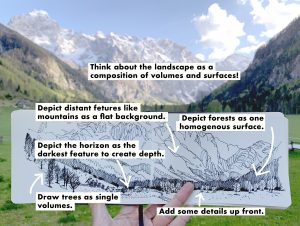
Tips that will help you improve your landscape sketches.
As designers or planners, we always use drawing with a certain intention. It is a tool. As with every tool, you need to know what you are using it for. Is it to document, to think and design, to communicate or to understand? Different ways to draw produce different results. If you know what your goal is when drawing, you’ll focus on it and produce better work.
When we draw landscapes on our trips or travels, we usually do it to understand what we see. Through drawing, we try to perceive the logic of the landscape, its structure, its elements and the connections between them. This enables us to grasp our environment better.
Why is drawing landscapes a challenge?
Landscapes are a complex subject to draw. Contrary to architects, landscape architects have to depict a subject that cannot be summarised as one finite object. A building is static, its boundaries clearly defined. A landscape, on the other hand, defies a clear definition of borders. It can be seen from many angles and always appear different. It’s best perceived when moving through it. So what to do when we try to depict it on a 2-dimensional surface?
Abstraction
There is a set of tools we can use to tackle the challenge. The most powerful tool we can apply is abstraction. Rather than attempting to depict the natural visual reality, which is immensely complex and hard to read, we can concentrate on the elements and the underlying structure of a landscape. Through the process of abstraction, we decide which elements of the landscape we want to draw and which we leave out. This depends on what exactly we want to communicate or record with a drawing.
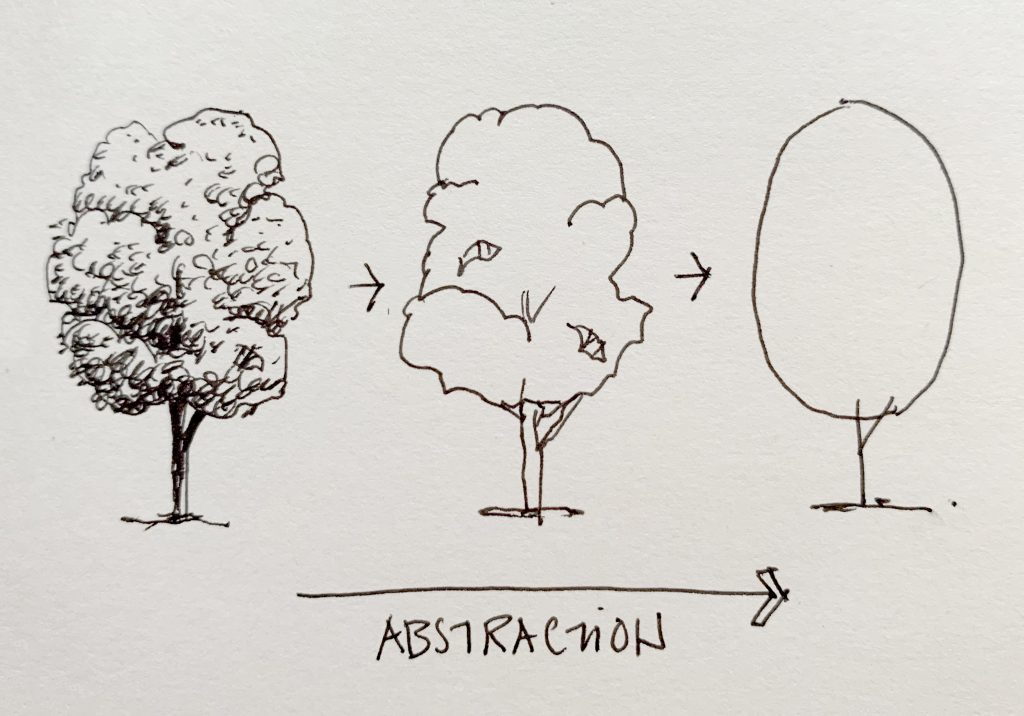
Three stages of an abstraction of a tree.
So how exactly do we abstract a landscape? By using symbols instead of naturalistically depicted landscape elements. Abstracted symbols are easier to draw and immediately recognizable. Landscape elements like trees or mountains are archetypal images. If we draw a simple circle with a line extending down from it, our brain will immediately recognize a tree. And not only our own brain – most people in the world, no matter their cultural background, will recognize that symbol as a tree.
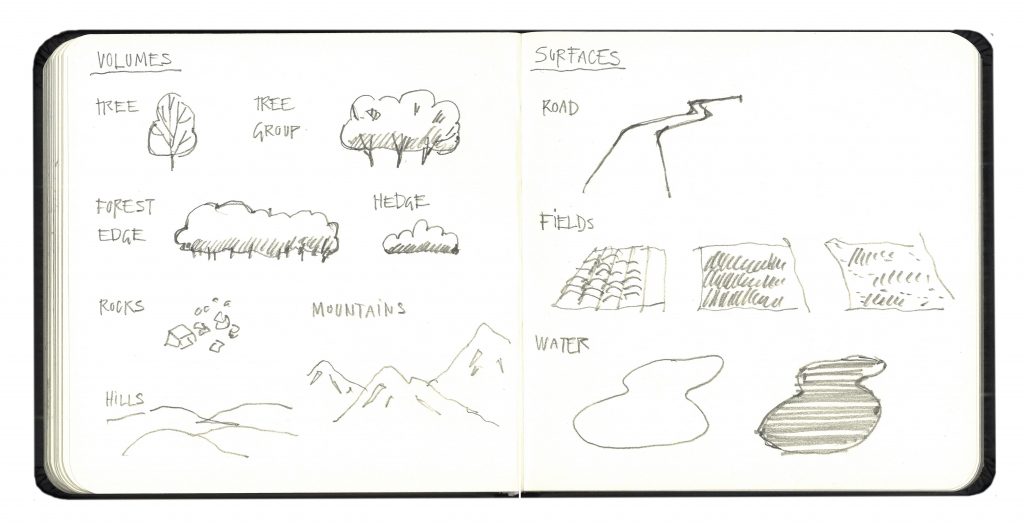
A sketch of volumes and surfaces from which a landscape is composed.
Surfaces and Volumes
The second useful trick that will make drawing landscapes easier for you is to think in terms of volumes and surfaces. It’s similar to the kind of thinking applied when designing a landscape. Every open space is composed of flat surfaces upon which volumes are arranged. This also applies in a natural landscape. Roads, meadows, and fields are perceived as surfaces, while vertical structures such as shrubs, trees, and hills are perceived as volumes. Thinking about them in this way will help you when drawing.

Think of landscapes as a composition of surfaces and volumes.
If you’re interested in more tips on drawing landscapes and want to delve into the topic further, you might find the video on drawing landscapes we did useful:
The final tip for drawing landscapes we can give you is to be aware that drawing is just a tool. It is one of many tools, like physical models or CAD, that helps us in our work. Don’t consider sketches to be artworks. Since a sketch is only a means to an end, it doesn’t have to look good. It just needs to be useful to you.
Published in Blog, Cover Story, Featured


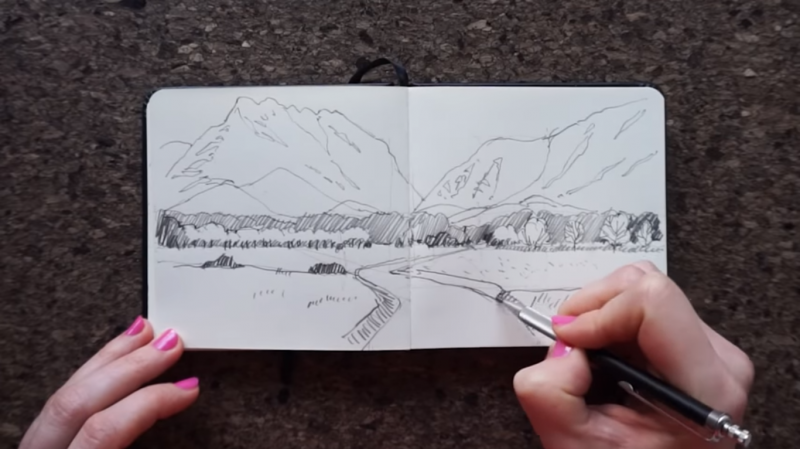
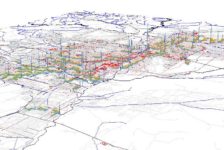

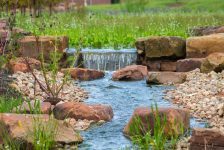


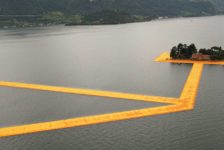
Tim Daugherty
Great tutorial and I love the video.
Linescapes
Hey Tim,
I’m glad you like it!
– Gasper
Kristin Faurest
We use Linescapes as preparatory material for our intensive seminar in Japanese garden arts here at Portland Japanese Garden. Because our program attracts landscape practitioners of all types — some are contractors or horticulturalists, for example, and not all of them draw — it’s great preparation and really helps reduce the phobia of doing the drawing assignments we give them! We’re fans.
Linescapes
Dear Kristin,
this is amazing and flattering to hear! It would be great to see the work you do there.
Best,
Gasper
J. Robert (Bob) Wainner
So GREAT to see this video and the authors showing such enthusiasm and the usefulness of landscape sketching “by hand”. I do sort of disagree with the last statement in this thread……that says “Don’t consider sketches to be artworks, since a sketch is only a means to an end. It doesn’t need to look good, it just needs to be useful to you”.
Well, when going thru the “design process” and creating “ideas” for a project…I do agree that, it really isn’t necessary for a sketch to look good…the hand sketching process is almost a necessary path to reach the final design solutions for a project. For me, I DO place importance on sketches….but really, only “hand drawn color renderings”…as these, when well drawn, become great marketing tools and are very helpful to communicate my “design ideas” to my clients.
Thank you both for that GREAT video….very well done!
Sincerely,
J. Robert (Bob) Wainner